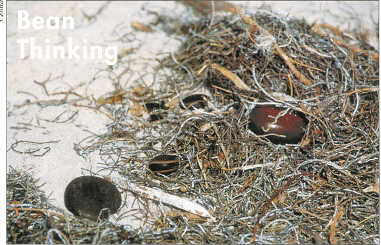 |
| The seeds of Entada and Mucuna species frequently land on Florida's beaches. The lianas that produce these seeds grow in the American tropics. |
Bean Thinking
Scott Zona, Ph.D., Former Palm Biologist
Consider the common bean, Phaseolus vulgaris. “Vulgaris” means common. In an enchanted time before franchises, television and shopping malls, anything commonplace was thought to be vulgar. And what could be more commonplace, more mundane than the lowly bean?
The more modern meaning of “vulgar” might come to mind upon seeing the many colors and shapes of common beans. At first glance, they look like field peas gone Hollywood, tarted up in sporty mauves and tans, flashy reds, or eye-popping black and white. Yet for all their myriad vulgarities, they are just one species, which was domesticated by indigenous Americans long before the voyage of Columbus. Careful and conscientious selection over many generations changed Phaseolus vulgaris in many significant ways. By saving and replanting seeds from bean plants with desirable characteristics, early agriculturists perpetuated certain genes and molded beans to fit their needs. In the domesticated crop, pods do not split open and scatter their seeds on the ground, as do wild beans. Yields were improved by selecting those plants that bore more flowers, and hence more fruits and seeds. The number of seeds per pod as well as the size of the seeds also increased. Different colored seeds were desired for different ceremonial, culinary, and personal needs. The domestication of the common bean is one of the great legacies of the indigenous people of the Americas.
As it turns out, the diversity seen in common beans is but a fraction of the diversity that evolution has lavishly bestowed on the bean family. It is the key to the family's evolutionary success. Legumes (as members of the bean family are called) have risen to dominance on virtually every continent except Antarctica. They have diversified over evolutionary time into an astonishing array of lianas, trees, shrubs, and herbaceous annuals. The family provides us with some of our most important crops (soybean, alfalfa, peanut), as well as some of our most pernicious weeds (kudzu). But for all their astonishing diversity, the family resemblance holds true in the seeds. They are all reconizably beans.
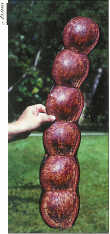 |
| The pods of Entada gigas are recognizably beans, albeit very large ones. |
Consider size. The fruits of Entada gigas and its relatives are certainly among the biggest bean pods in the world. A single pod may grow to two or more meters long (more than six feet!) and 15 cm (six inches) broad. The pod is woody and heavy, but it breaks up to release the seeds, which float and are dispersed by the streams and rivers on whose banks Entada grows. Some seeds are swept out to sea, and although they can survive for some time in the salt water, it is doubtful that the seeds could ever germinate in a salty environment. The seeds of Entada species often wash up on Florida’s beaches, where they are called “lucky beans.” As a child, I could not resist collecting them at the shore, and I often wondered what sort of magical beanstalk might grow from these seeds. If any beans could have possibly grown into a beanstalk that led Jack to a giant’s castle, then surely these were the beans! (I was always more interested in the beanstalk than I was in that thieving and murderous Jack.) When I finally saw, in the islands of Vanuatu, the liana and its immense pods, they seemed even more fantastic than any fairytale plant.
Another kind of bean that washes up on our shores is Mucuna spp., commonly called “hamburger bean” because of its distinctive shape, like two buns enclosing a brown patty. Species of Mucuna are lianas of disturbed areas, fiver banks, and light gaps. Some are cultivated for livestock forage and soil improvement (like most legumes, they fix nitrogen). Their pods are the scourge of botanists walking through these areas, as they are often covered by fine, fragile hairs, which break off and cause painful skin irritation. The pods split open (dehisce) when ripe and scatter the distinctive seeds, some of which end up in rivers and are washed out to sea. Along with Entada, Mucuna seeds are some of the most common “sea beans” found on Florida’s beaches.
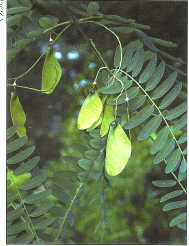 |
| The winged fruits of Tipuana tipu are wind-dispersed beans. |
Not all bean pods split open at maturity. Some don't open at all and are called indehiscent. Tipuana tipu is a South American legume tree that is occasionally cultivated as an ornamental in the United States. It is fast-growing, with many of the traits of a pioneer species, a tree that colonizes newly cleared land or newly available habitats. Its pods have taken up gliding as a dispersal mechanism. The pod contains only one seed and bears a flattened, aerodynamically sound wing. In both form and function, Tipuana’s fruits are like those of maples (Acer), gliding upon air currents and taking the chance that they will land in a good growing spot.
The peanut (Arachis hypogaea) is a familiar example of a legume that takes no such risk and shuns both air and sea travel. Peanuts have a peculiar dispersal mechanism that precludes a dehiscent pod: They bury their pods underground, effectively sowing their own seeds. The flower is, of course, borne in the upper branches of the plant, but once the flower has fallen and the ovary begins to swell, the flower stalk elongates and turns downward. By elongating the stalk, the peanut pushes the developing fruit underground, thereby planting next year's crop. The specific epithet, hypogeae, means “underground” and draws attention to this unusual mode of reproduction. Interestingly enough, the peanut is not the only legume to do this, indeed it is not the only plant to do this. Florida’s endangered burrowing four-o’clock (Okenia hypogaea), which is in the Four O’Clock family, totally unrelated to legumes, buries its fruits in the sand-dunes in which it grows just as peanuts do.
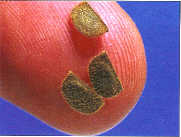 |
| The fruits of Desmodium break up into single-seeded segments that hitch rides on passing animals. They cling to fur and socks by means of tiny hooked hairs. |
Some legume pods don’t open but rather break apart into sections, each section containing one seed. Beggar’s ticks (Desmodium spp.) are familiar examples of such a legume. Desmodium spreads its seeds by hitching rides on passing animals. The pod surface has tiny hooked hairs, which grab onto fur (or socks) and hold fast like Velcro®. In fact, it was another animal-dispersed plant, the cocklebur (Xanthium strumarium, in the Sunflower family), unrelated to Desmodium, that inspired Swiss mountaineer George de Mestral to invent Velcro in 1948. Had the curious George been hiking through weedy vegetation in the American tropics, Desmodium might easily have been the plant that inspired a revolution in fastening.
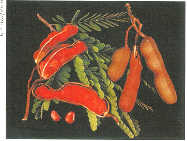 |
| The tamarind has an edible tart pulp surrounding the seeds. |
Tamarind (Tamarindus indicus) disperses in yet another way. It too relies on animals, but by possessing an edible fruit, it induces animals to carry the seeds internally, rather than externally. Tamarind has a fleshy, pleasingly acidic pulp around the seeds. The pulp is aromatic and soft when the seeds are ripe. Animals eating the fruit invariably ingest seeds, which are later voided. Inga, another tropical legume, also has edible pulp. Its fruits produce a sweet, cottony pulp around the seeds. Inga is known as ice cream bean, although in my opinion, Inga has a long way to go to catch up with Ben and Jerry.
“Domination Through Diversity” might well be the legume family motto. Through differences in fruit form and function, along with differences in growth habit, biochemistry, and flower form, legumes have made themselves at home in nearly every part of the world. From the steppes of Russia, where legumes are herbaceous annuals, to the Amazon Basin, where legumes are woody llanas, shrubs and trees, this family of plants is everywhere, in every shape and size. In the tropics, legumes have evolved into one of the richest and most commonly recognized plants. By their seeds you will know them. The lowly roadside weed and the towering rainforest giant are both just beans. Beans, prosaic and plain. They are the stuff of greatness.
Garden Views Spring 2002